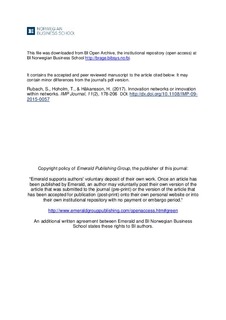| dc.description.abstract | Purpose: The purpose of this paper is to present a longitudinal case study of a regional innovation policy initiative, in which ideas with regard to how innovation might be facilitated were changing over time. Through the scrutiny of insights in industrial network studies (IMP), the authors seek to shed light on the challenges created by policy interventions aimed at constructing complementary networks for the facilitation of innovation. That is to say, the authors endeavour to understand the interfaces between innovation networks and industrial networks, and the way in which they may influence innovation.
Design/methodology/approach: This study is based on a longitudinal case study of four successive regional innovation projects in Norway. Data are drawn from relevant policy documents and project documentations, as well as from participatory observation of application processes and project activities.
Findings: This study shows that regional innovation policy concerns first and foremost the interaction within and between relatively established diverse networks, which affects both structuring and restructuring. Changes in innovation policy required the re-configuring of constellations of business networks, research networks and policy networks. All initiatives required mobilisation input by persistent actors – often boundary organisations or researchers. The construction of innovation networks served as an instrument in the production of new interfaces between businesses, researchers and policy makers. The use and usefulness of these networks as perceived by the business actors were heavily influenced by the way in which the networks were configured.
Research limitations/implications: Generalisation based on in-depth qualitative case research requires further testing across similar and varying cases, and there have hitherto been relatively few studies of the interfaces between industrial and innovation networks. Despite this it can be argued that the conceptual distinction between constructed and emerging networks is a productive one in the study of networked innovation dynamics. During the research into this longitudinal case, it has been interesting to observe the way in which innovation research, and thus its influence on innovation policy, has changed over time. It would be beneficial if further studies were to be conducted on the way in which this has played out.
Practical implications: The administration of the public funding of innovation network activities requires great care. Where innovation policy initiatives are closely related to established industrial networks, it may be possible to strengthen innovation dynamics, challenge established practices and conceptions, and contribute to expanding, or even initiate innovation activities. In the first place, new activities need to be initiated in a way that supports the long-term development of actual business networks; and second, innovation policy bodies should be prepared to stimulate activity over longer periods of time.
Originality/value:This paper engages in, and combines, two parallel and rarely interacting debates on, respectively, innovation within innovation policy (innovation systems, clusters, networks) and industrial network studies (IMP and others). The authors make an “ideal type” distinction between alternative “constructed” networks and “emerging” networks, and the way in which they influence innovations. | nb_NO |
